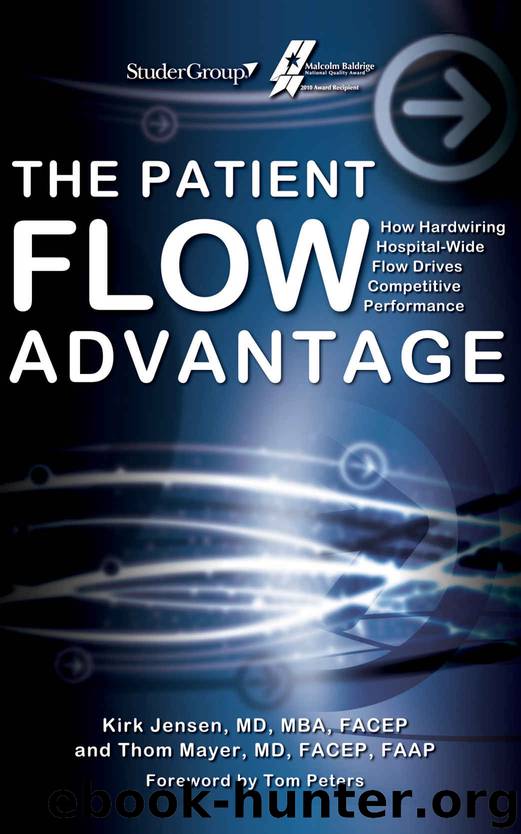The Patient Flow Advantage: How Hardwiring Hospital-Wide Flow Drives Competitive Performance by Jensen Kirk & Mayer Thom

Author:Jensen, Kirk & Mayer, Thom [Jensen, Kirk]
Language: eng
Format: epub
ISBN: 9781622180936
Publisher: Fire Starter Publishing
Published: 2016-01-19T16:00:00+00:00
COORDINATING HOSPITAL WIDE FLOW
The importance of patient flow in healthcare has become increasingly recognized in the past decade or so. Hospitals are taking steps to improve flow, healthcare professionals are seeking out training in flow improvement, and national organizations are acting to emphasize the need to improve flow. In the first years of this century, The Joint Commission established an accreditation standard requiring hospital leaders to “develop and implement plans to identify and mitigate impediments to efficient patient flow throughout the hospital” (Joint Commission Resources Leadership Standard LD.3.10.10, effective January 1, 2005).
The Joint Commission recently put into effect new performance standards whereby the chief executive officer, medical staff, and other senior managers in a hospital must set specific goals to improve patient flow, including ensuring availability of patient beds and maintaining proper throughput in labs, operating rooms, inpatient units, telemetry, radiology, and post anesthesia care units. These new requirements became effective January 1, 2013 (Schneider 2013).
The Joint Commission has said recently that “boarding in the ED requires a hospital wide solution” (Schneider, 2013). Lynne Bergero of The Joint Commission added, “We want to make sure that organizations are looking at patient flow hospital wide, even if the manifestation of a flow problem seems to be in the emergency room.”
To reach this goal, The Joint Commission has mandated that hospitals form hospital wide flow committees to examine processes, analyze data, and implement ongoing improvements. This kind of committee can be key in coordinating flow improvement efforts. To succeed, it must include senior leaders—for example, the chief executive officer, chief operating officer, chief medical officer, and chief of emergency medicine—as well as appropriate representatives from various units.
Since few healthcare professionals understand flow and systems management better than ED practitioners, for whom minutes and hours are critical concerns, ED clinicians are essential participants on—or chairs of—these committees. In fact, few understand the timely management of people and resources better. As in any effort of this kind, the commitment and persistence of the leaders will determine how well the hospital improves flow. But when a hospital-wide committee with clout is serious and determined, it can achieve impressive results.
Download
This site does not store any files on its server. We only index and link to content provided by other sites. Please contact the content providers to delete copyright contents if any and email us, we'll remove relevant links or contents immediately.
Good by S. Walden(3485)
The Social Psychology of Inequality by Unknown(2936)
0041152001443424520 .pdf by Unknown(2783)
The Checklist Manifesto by Atul Gawande(2776)
The Meaning of the Library by unknow(2503)
Guns, Germs and Steel by Diamond Jared(2303)
Borders by unknow(2227)
23:27 by H. L. Roberts(2195)
And the Band Played On by Randy Shilts(2127)
Get What's Yours for Medicare: Maximize Your Coverage, Minimize Your Costs by Philip Moeller(2082)
Being Mortal: Medicine and What Matters in the End by Atul Gawande(2081)
A Leg to Stand On by Oliver Sacks(2003)
The Hot Zone by Richard Preston(1982)
The Valachi Papers by Peter Maas(1810)
The Laws of Medicine by Siddhartha Mukherjee(1754)
The Andromeda Strain by Michael Crichton(1696)
The Obesity Epidemic by Robyn Toomath(1644)
Pharmacy Practice and The Law by Richard Abood(1541)
Autism's False Prophets by Paul A. Offit(1492)
